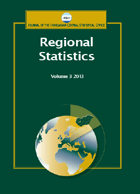Opportunities for walkability in Szeged and Valencia
Opportunities for walkability in Szeged and Valencia
Author(s): Szűcs Petra, Lukovics Miklós, Kézy BélaSubject(s): Social Sciences, Economy, Geography, Regional studies
Published by: Központi Statisztikai Hivatal
Keywords: walkability;city development; sustainable urban mobility; community economic development;
Summary/Abstract: Cities traditionally concentrate a country’s resources and talents, and, thus, they have long been the hubs of innovation and economic growth. Recent rapid urbanization has brought numerous challenges to our cities, including overcrowding, noise, and air pollution, to name a few. One area in which cities urgently need to innovate is urban mobility. The use of motorised vehicles requires increasing amounts of space, which drastically reduces the amount and quality of living space for people. This results in various negative economic and social consequences. To improve the sustainability of urban mobility, cities develop environmentally friendly public transit systems and bicycle infrastructures. However, improving the simplest and most basic type of mobility—walking—has long been neglected. Fortunately, urban developers have increasingly realized during the past few years that making our cities more walkable is a critical part of the solution to the urban mobility challenge. This paper aims to answer the question: ‘How is the concept of walkability interpreted in middle-sized European cities’. During our research, we conducted intercept surveys (participant observation, questionnaire, and experts’ interviews) to investigate the extents of walkability and its improvement opportunities in Szeged and Valencia. We evaluated the findings using descriptive statistical methods. We conclude that the concept of ‘walkability’ could be useful as a city development tool in mid-sized cities.
Journal: Regional Statistics
- Issue Year: 7/2017
- Issue No: 01
- Page Range: 152-178
- Page Count: 27
- Language: English

